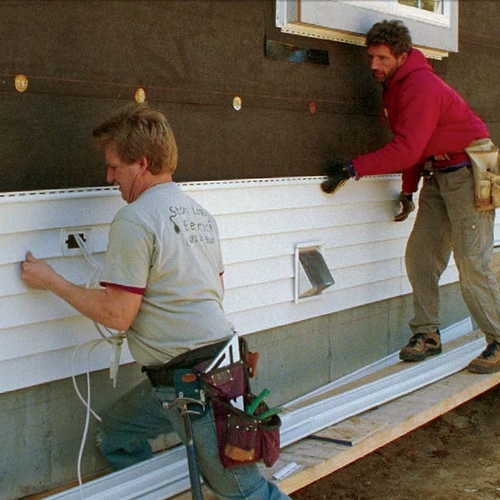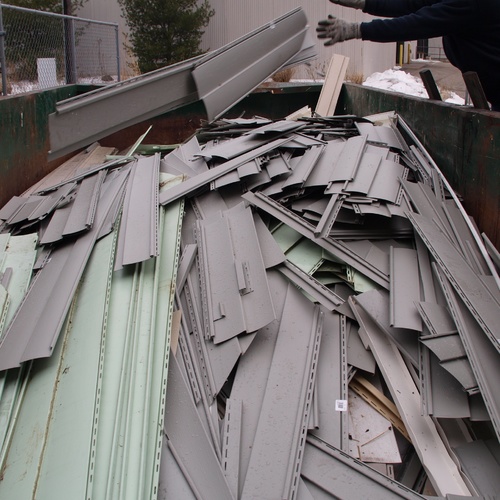
Image Credit: C.J. Hilado, “Flammability Handbook of Plastics,” 1982
A recent blog of mine, “The Counterintuitive Cladding,” discussed the “green” bona fides of vinyl siding. The blog struck a variety of nerves, including from those who mistook an obvious opinion piece for a poorly written scientific paper.
That said, my blog was not based on fantasy. It was based on decades of home construction experience as well as science, which defines what we believe today as much as religion did in the past. Unfortunately, science does not always confirm what we want to believe, and is not so easily interpreted to suit our biases. Just ask climate change deniers.
I’ve had to vigorously defend my projects from criticism before – not just for vinyl siding, but for other green technologies such as advanced framing and frost-protected shallow foundations. In the process, I learned a lot about these technologies and I am a much better builder for it, so I welcome the opportunity to engage in rigorous debate. I know that many of the vinyl siding critics won’t be swayed, but for those with open minds and an interest in facts, please consider the facts that follow.
Weekly Newsletter
Get building science and energy efficiency advice, plus special offers, in your inbox.
Information from USGBC
Several readers cited LEED to confirm their negative attitude toward vinyl siding. The USGBC’s “Assessment of Technical Basis for a PVC-Related Materials Credit in LEED” report was broad and made many claims. Overall, the report embraced the Life Cycle Assessment approach.
According to life cycle models, such as BEES (Building for Environmental and Economic Sustainability, which was developed by the National Institute of Standards and Technology as a way to compare building products from a life-cycle perspective), vinyl siding proved to have a lower environmental impact than most other claddings except wood. But to have a lower impact, wood must remain unfinished. That means no stain and no paint, which is hardly realistic.
On pages 58-59, the USGBC report makes the following claims about vinyl siding: “In terms of the relative performance of the different material options, the following general conclusions can be drawn. First, wood siding performs quite well; its maximum values are typically below the maxima for all other material options for most impact categories, and the midrange of its values is often the lowest of the four materials’ midrange values. Note that an important caveat is our assumption of no painting to the wood siding.
“Another general conclusion is that fiber cement tends to perform the worst among the options, for most impact categories; the maximum value of its range tends to be at or among the highest within each impact category. The value ranges for fiber cement tend to be higher than those for PVC for most impact categories. For human health impacts of fiber cement, the highest values are based on the BEES data that assume the Portland cement content by 90%. Although other data sources such as MSDS do not specify Portland cement for the content, those high values have been kept since use of Portland cement for fiber cement siding can be reasonably assumed.”
Note that the BEES analysis cited in my report was based on publicly available data submitted by individual companies; however, the fiber cement industry did not cooperate, hence the need for assumptions. I like fiber cement for certain applications and have used it, but it’s not a better environmental option than vinyl siding. Science says so.
In the report’s Conclusions and Recommendations (page 98), the USGBC writers state: “Therefore, the current body of knowledge as analyzed in this report in Section 3 as it relates to the Task Group’s charge from TSAC does not support a credit in the LEED rating system for eliminating PVC or any particular material. Further, with respect to a PVC-related credit, the available evidence indicates that for some product categories, such a simple credit could steer designers to use materials which performed worse over their life cycles with respect to the bulk of the impact categories” — such as fiber cement.
Getting credit for using vinyl siding
The most popular rating systems in the residential market are LEED and the ICC 700. Both give credit for the use of EPDs (or LCA information).
In addition, the ICC 700 gives credit for products that do not require on-site finishing, recycled content, termite resistance — meaning they both give credits for vinyl siding. I know this because I have taken advantage of it.
Living Building Challenge
On the other hand, the Living Building Challenge created a red list against PVC (which the USGBC recommended not doing in their report).
Overall, the concepts of the Living Building Challenge are beautiful, and I have written very positively about the program, but it is not among the most influential rating systems, was not developed under any type of consensus or ANSI process, and, as far as I know, it is the only one with a proscription against the use of vinyl siding.
The vinyl siding manufacturing process
A few readers referred to manufacturing impacts, specifically referring to dioxin. I wonder if any of you have been to a vinyl plant. I have, and also to paper mills, brick factories and lumber mills. The vinyl plants are much cleaner, and have no perceptible impact on the surrounding environment or residential community. By comparison to brick factories, lumber mills and I am told fiber cement plants, vinyl is a clean technology.
But I cite the Environmental Protection Administration’s words in support of my experience:
- “Dioxin levels in the environment have declined significantly since the 1970s, following EPA regulatory controls and industry actions. EPA’s best estimates of emissions from sources that can be reasonably quantified indicate that dioxin emissions in the United States decreased by about 80 percent between 1987 and 1995, primarily due to reductions in air emissions from municipal and medical waste incinerators, and substantial further declines continue to be documented.” (“Dioxin: Summary of the Dioxin Reassessment Science,” Information Sheet 1, U.S. EPA, June 12, 2000.)
- “As a result of EPA’s efforts, along with efforts by state government and private industry, known industrial emissions in the United States will be reduced by more than 90 percent from 1980 levels within the next year or so.” (“Questions and Answers about Dioxin,” Interagency Working Group on Dioxin, July 2000).
The warnings on phthalates were rebutted by other readers, but it pays to reiterate that vinyl siding is rigid PVC, which does not contain phthalates.
Fire danger
Here again, intuition is a poor substitute for knowledge. It would seem that vinyl siding would be highly flammable, but in fact it’s not.
Composed mainly of polyvinyl chloride (PVC), vinyl siding’s chlorine base makes it harder to ignite and easier to extinguish. PVC won’t ignite, even from another flame, until it reaches about 730°F (387°C), and won’t self-ignite until about 850°F (454°C). Those ignition temperatures are significantly higher than common framing lumber, which ignites from a flame at 500°F (260°C) and self-ignites at 770°F (410°C). This, in part, explains why most vinyl siding can meet the stringent flame requirements for fire safety required by the International Building Code (which is adopted by every state). In addition, some vinyl siding is allowed to be used on ASTM E119 fire rated assemblies, because it does not contribute to the growth of the fire.
What about smoke?
Vinyl siding opponents often claim that the siding will smoke when burning and that the vapors are highly toxic. Even if you have a fire lapping at the siding at the nearly 700°F you would need for vinyl to burn, the toxic potency of vinyl would not be considered to be any different from that of wood when burning, since all burning materials release highly toxic smoke.
The most important toxic product in any fire is carbon monoxide (CO), which is produced by all organic compounds as they burn. Vinyl releases less CO than most wood products, and as such its contribution to overall toxicity in a house fire is negligible (according to NIST Radiant Toxicity Test Results).
Of course, all of this only matters if you install vinyl siding on interior walls. On exterior walls the net toxicity of vinyl siding in a fire is virtually zero. To get into the science, I refer you to a commonly referenced authoritative document on the subject, Casarett & Doull’s “Toxicology – The Basic Science of Poisons.”
My reference to “Blue Velvet”
All right, touché: The David Lynch movie “Blue Velvet” has nothing to do with vinyl siding.
But “Blue Vinyl,” the Daniel B. Gold and Judith Helfand movie on the manufacture of vinyl siding and one woman’s search for an alternative, was responsible in part for today’s prejudice against the product. In any event, I’m not sure of the validity of comic documentary as a basis for choosing building materials. Consider the facts noted above from the EPA about dioxin reduction in the U.S., and that while the overall use of products made from of vinyl has gone up dramatically, dioxin release has also gone down dramatically. Let’s give credit when it’s due.
While I hope I’ve soothed some of the nerves jangled by my previous post by presenting additional facts and citations, I know that misperceptions run deep and minds are frustratingly hard to change. I imagine that’s why Mark Twain said, “Never let facts get in the way of a good story.”
Fernando Pagés Ruiz is a builder and author. He has developed, built, and remodeled homes in California, Nebraska, and Wyoming, and has won a number of awards, including recognition from the National Association of Home Builders.
















20 Comments
unfinished wood
Here in New England, white cedar shingles are commonly used for siding. While some people stain them, they perform just fine with no finish at all, weathering to a nice grey. I'm putting them on my new house. Another green benefit is that they are manufactured in Windsor ME, just a few miles from my house.
Response to Stephen Sheey
Stephen,
Unfinished white cedar shingles are my favorite siding as well. I've been building houses with cedar shingle siding for 35 years. The oldest houses still look good.
Stephen
Our there in the PNW it was red cedar shakes. A lot of the older house near here had them on for decades, then pulled them off and turned them around!
Fernando
Thanks for taking the time to flesh out your earlier blog, the combination of the two makes for an interesting read and appears to make a good case for vinyls' rehabilitation.
Well said
Thanks for the reminder that we're supposed to be discussing building science
finding quote from report
I'm having trouble finding the quote about wood being unpainted in the linked report. I find instead
"A painting cycle of 6 years was assumed. The paint was assumed to consist of water-based 71% of the time and solvent-based 29% of the time" (p. 1 as numberd = p. 7 of the pdf file)
works for me
I've probably mentioned this before; I *specified* vinyl for my reno and
haven't regretted it at all [despite the gentle ribbing my contractors
were handing me]. It's zero maintenance. I can nondestructively
*take it apart* when I need to, and zip it right back up afterward.
In a rainscreen setup, I can simply run my hand along it with gentle
pressure to find where the strapping is, if I have to attach something
to the wall like a cable anchor or the like. [Downside of that is it
limits where you can put downspout brackets, so plan ahead on where
to cut in downspout takeoffs relative to the house.]
How about Azek trim, or Trex decking?? Same stuff, and volume-wise it
seems to me that *one* piece of cellular-PVC trim board would equal
*several* pieces of vinyl siding. Now think about that vast expanse of
grey on your back deck. Nobody seems to be griping about using that
in high-end remodels, are they.
Now, the big trick would be to get any plastic recyclers to realize that
they *should* accept cast-off siding, for the same "free" as they take any
other #3 items. I chased all over the place trying to find somewhere
that would take my extra, and finally managed to donate it to Habitat.
_H*
Hobbit
A lot of the prejudice against vinyl may just be fashion, but where does that leave us as designers? Much as we may pretend otherwise, the majority of the decisions that go into a house are based on cultural or social preferences, not any hard-nosed logic around efficiency. Perhaps the message we should take way from Fernando's blog is that we should be open about why we don't like vinyl and not try to use building science to back our prejudices.
Plastic houses not for me
Being as green as possible is important, but it shouldn't always trump all other considerations. To me, plastic on a house is just plain ugly. And totally inappropriate on an historic structure.
The maintenance issue also seems over-exagerated. There are plenty of 100+ year old houses with original wood siding, and a good paint job on wood can last 20 - 30 years. I question what vinyl siding will look like when it is 100 years old.
As far as fire resistance, I think you'd need to test the full wall assembly before coming to any conclusions. The surface burning characteristics do not consider the time it will take to burn through the siding and expose the sheathing. And fiber cement should get some points for being fire resistant. After all, it is usually far more eco to preserve an existing house than to have to replace it with another structure.
Duh
That's precisely Fernando's point. Make a decision on vinyl siding on whatever basis you want, including (or perhaps especially) that it's ugly, but don't assume there's no green argument to be made for it, and don't condemn it on that basis.
Dan
It may be an obvious point, but it appears to be one that most posters seem not to want to concede.
Tough one
I'm loathe to use vinyl myself, but that's my (and my clients' ) call. I appreciate Fernando and groups like USGBC doing the hard work to look at the data.
Death and plastic
Great article. I appreciate your ardor in discussing this topic while running the risks of being labeled a heretic.
I am not a big fan of vinyl siding, but good vinyl can certainly fit a need and I believe, be a long lived alternative.
Two noteworthy items:
1. I recall Norm Abrams on This Old House talking about using cellular vinyl trim to replace pine that he had to replace two or three times over the time the series "The New Yankee Workshop"was on TV.
I have to anticipate that Norm did all the right things in terms of preparation and finish.
2. I came across a study where a lot of innocent mice gave up their lives being exposed to smoke from various burning materials. The time to death (I know, it is a repulsive study!) was shorter for natural materials and longer for polymers.
I would not want to breathe smoke from any fire, but sensible use of plastics might have its place.
I live on a house on the coast of Maine. It has had many many repairs over the years due to weather related moisture failures. All the trim is now Azek. Was that the best choice? I think it was in this case.
Why does Fernando, in his
Why does Fernando, in his discussion of the toxin Dioxin, avoid discussing dioxin in relation to polyvinyl chloride siding's manufacture and use?
Hobbit says one "can nondestructively *take it (pvc siding) apart* when I need to, and zip it right back up afterward." This is true - when the product is new, but after it has some age it becomes brittle and usually cracks when being removed, making it an unlikely candidate for reuse or recycling. At which point it goes to the incinerator where some of those nasty toxins are released.
So the question: what is the plan for the recycling of this product?
Response to Bob Irving
Bob,
Concerning dioxin and vinyl siding: "Dioxin emissions and levels in the environment are declining, according to data from the U.S. Environmental Protection Agency (EPA). Dioxin emissions from human sources in particular have declined by more than 90% in recent decades, and further declines continue to be documented. This has occurred even as production of vinyl has soared, proving that vinyl production and disposal are not significant contributors to dioxin levels, accounting for less than 1% of total dioxin releases to the environment. This simple fact indicates that there is no significant relationship between vinyl use and aggregate dioxin releases to the environment."
Concerning recycling: vinyl siding can be recycled. The problem is not that recycling is technically difficult; the problem is that there are currently no regulations requiring vinyl to be recycled. For more information, see:
Recycling Vinyl Siding
Job-Site Recycling: PVC
Standards of proof
Fernando characterizes his previous blog as "an obvious opinion piece". Nothing wrong with that, although he titles it as "truth", and almost every paragraph seems to assert that he is presenting valid data and logical conclusions. It seems like he's trying to play both sides, with his simultaneous claims of truth and obvious opinion.
Martin quotes a report, which states that two contemporaneous statistics constitute proof of various desired conclusions. I have higher standards for proof. A lot of the contentiousness in this debate stems from blurring of the lines between opinion, advocacy, and careful research.
Shades of truth
It concerns me that in the initial pieces, the author said that rating systems give credit for vinyl siding, yet in this piece it is clarified that they give credit for EPDs. Since some manufacturers of vinyl siding have EPDs then that means the rating system gives credit for use of vinyl siding? I think not.
It is this shading of the truth that makes me critical of the information in this article (and the first). This "shading" has also reaffirmed my approach to try to find and use non-plastic products when it makes sense, because of the potential for harm. In a case where up-front cost is paramount, and durability perhaps an issue, then I would HAVE to consider a vinyl siding and weigh its use against concerns and weigh other siding options (or wall-system designs) against possible cost gains reflected in other systems. However, I do still have serious concerns about off-gassing as well as production and disposal toxic burdens, and will continue to research and discuss those concerns with project teams.
vinyl melting in the sun
Martin has covered this before but here it is again, people being abandoned by the builders and the manufacturers as their houses melt. http://abc7chicago.com/home/melting-vinyl-siding-raises-concern-among-suburban-homeowners/725468/
Vinyl siding can melt
Here is a link to the article that Lloyd Alter is talking about: Window Reflections Can Melt Vinyl Siding.
Dioxins have been reduced. Isn't that just grand?
However "Cancer Alley" the stretch of Louisiana where most of our plastics and vinyls are STILL being manufactured remains one of the US areas with the highest cancer prevalence rates.
There was a fine article about it in the 4/19/2020 edition of the Washington Post. The problem remains as real as ever. I encourage readers to do a quick Google Image search of "cancer prevalence by county", check out the images that show the US county map and compare that to where vinyl is manufactured.
As far as using recycled material, I'm all for using up what we've got by recycling it. But we should be doing everything we can to minimize the new supply.
When I worked on home remodeling projects in California I routinely encountered 3-coat cement stucco applications that were as good as new after 80 years of service. Like Martin Holladay I also recommend cedar siding and shingles. They last for many decades and are fully, 100% recyclable and even better, compostable. They also sequester carbon. But I challenge people to show me vinyl siding that routinely lasts more than 20-30 years and retains its visual appeal and full functionality.
Log in or create an account to post a comment.
Sign up Log in